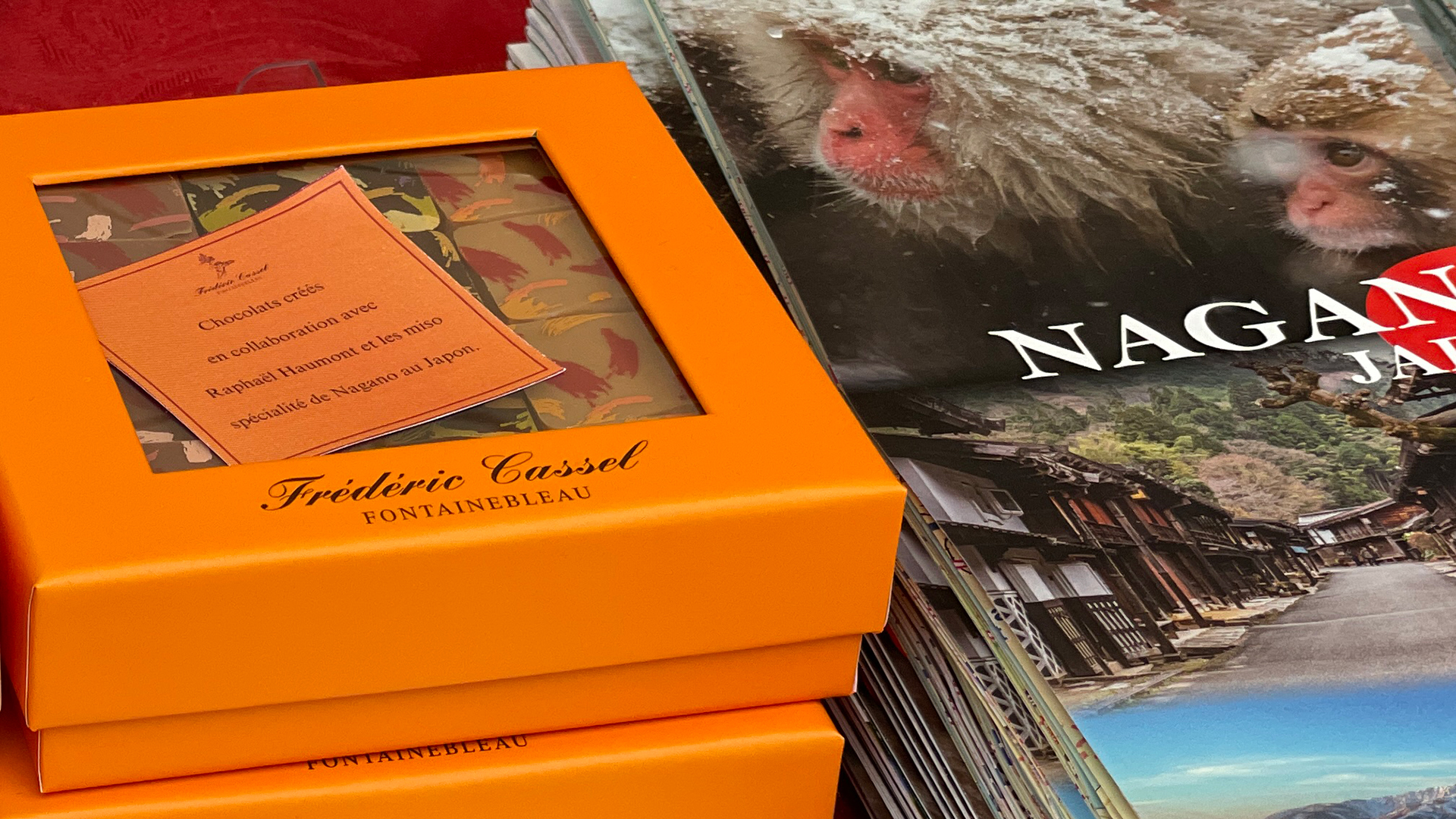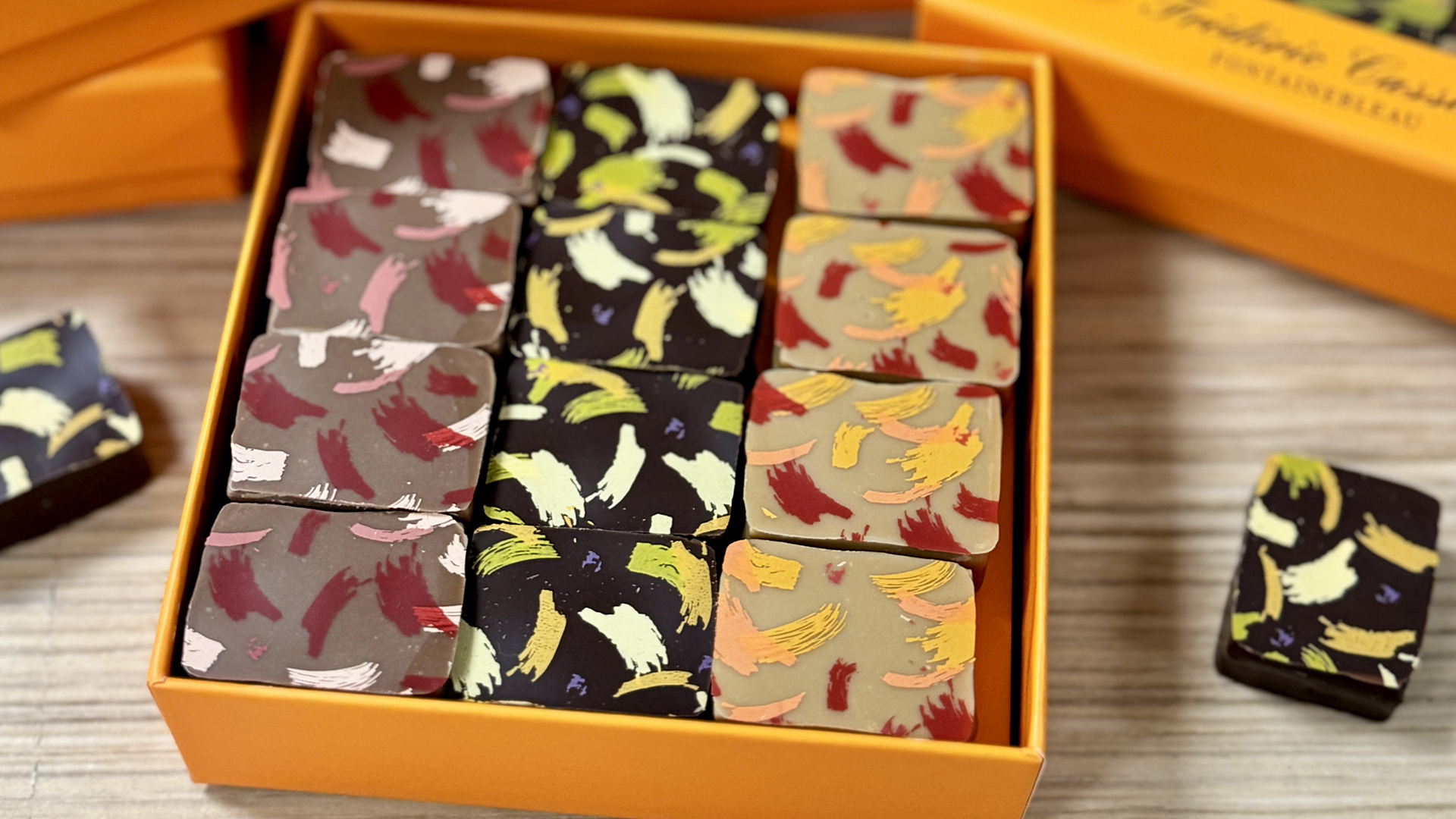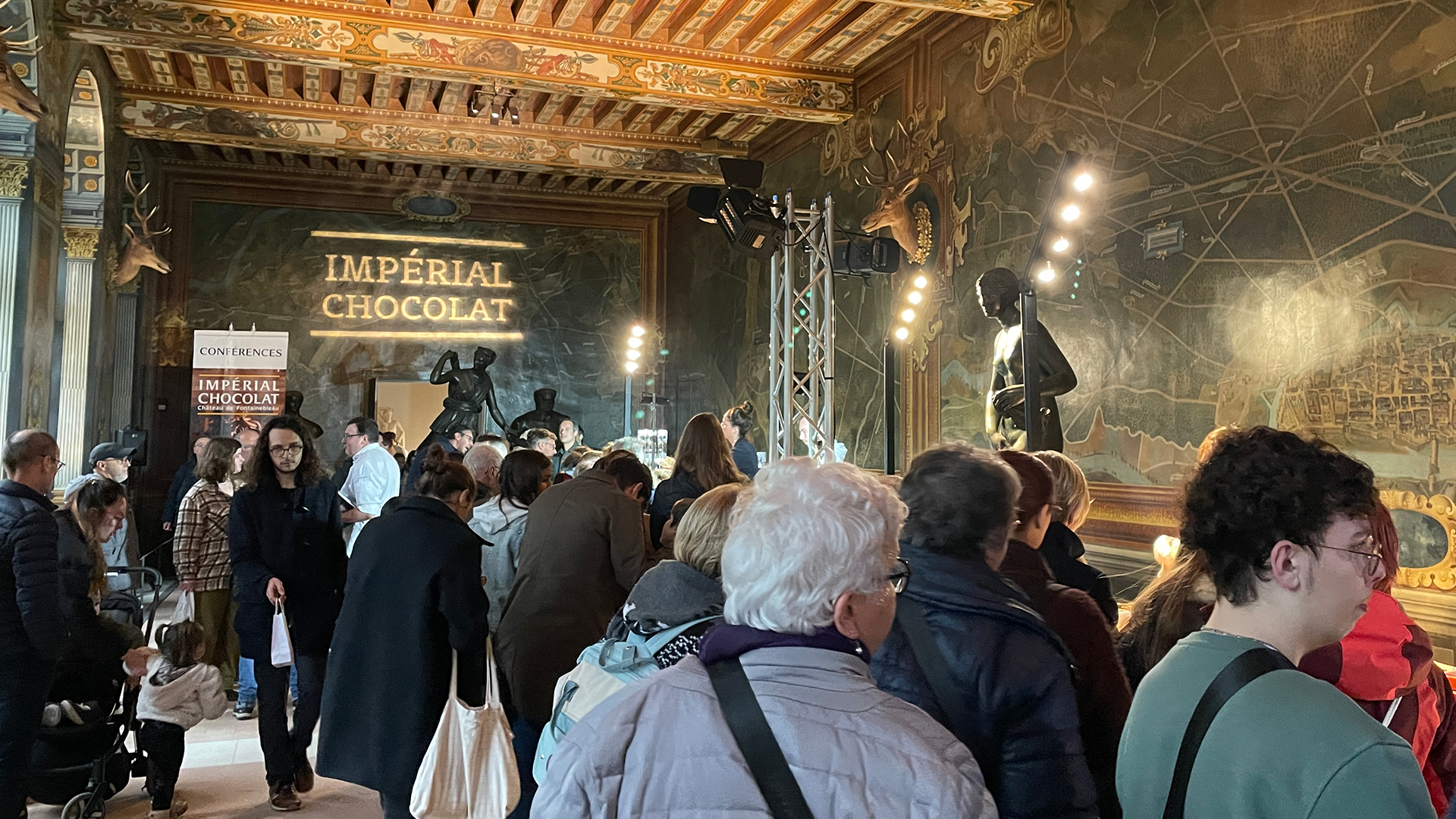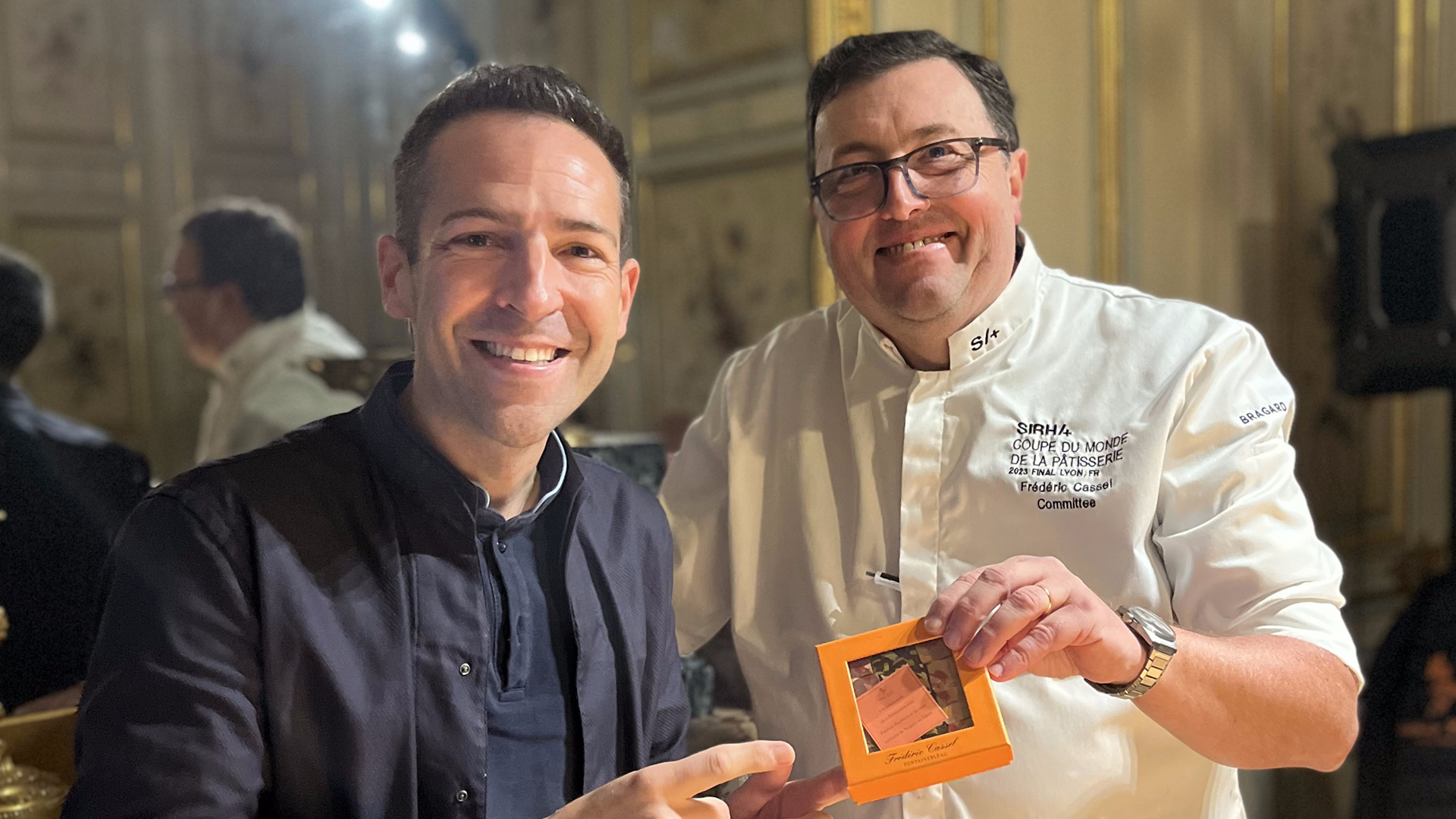
Creation in France of a New Chocolate Made with Nagano Miso!
信州味噌を使用した味噌ショコラがフランスで誕生!
Frédéric Cassel, President of Relais Dessert and renowned pastry chef, along with molecular gastronomy researcher Raphaël Haumont, have developed this fantastic chocolate using an essential ingredient from Nagano’s terroir: Nagano Miso.
In October 2023, Mr. Haumont visited several miso factories in Nagano Prefecture, where he discovered the richness of this traditional ingredient and the region’s hilly terrain. He then introduced Mr. Cassel, who only knew miso through “miso soup,” to the intricacies of Nagano Miso. Mr. Haumont scientifically analyzed the composition of three types of Nagano Miso (white miso, red miso, and reduced-salt miso) and, based on this, selected ingredients compatible with miso. Together, they spent three months developing three varieties of miso chocolate. This familiar ingredient for the French harmonized perfectly with Nagano Miso to create delicious and unique flavors. Thus, three miso chocolates were born, redefining what “chocolate” can be.
In October 2023, Mr. Haumont visited several miso factories in Nagano Prefecture, where he discovered the richness of this traditional ingredient and the region’s hilly terrain. He then introduced Mr. Cassel, who only knew miso through “miso soup,” to the intricacies of Nagano Miso. Mr. Haumont scientifically analyzed the composition of three types of Nagano Miso (white miso, red miso, and reduced-salt miso) and, based on this, selected ingredients compatible with miso. Together, they spent three months developing three varieties of miso chocolate. This familiar ingredient for the French harmonized perfectly with Nagano Miso to create delicious and unique flavors. Thus, three miso chocolates were born, redefining what “chocolate” can be.

(From left to right)
– Praliné Maison Noisettes Miso (Miso, Praline & Hazelnut)
– Ganache Café Miso (Miso & Coffee Ganache)
– Ganache Framboise Miso (Miso & Raspberry Ganache)
These creations were presented in the historic town of Fontainebleau, located in the Parisian suburbs, surrounded by deep forests and home to the Château de Fontainebleau, a UNESCO World Heritage Site. The chocolates were first unveiled in November 2024 at the pastry and chocolate shop “Frédéric Cassel,” located in the town center. They were also sold during the 7th edition of the chocolate festival “Impérial Chocolat & Gastronomie,” held at the Château de Fontainebleau from November 9 to 11, 2024.
– Praliné Maison Noisettes Miso (Miso, Praline & Hazelnut)
– Ganache Café Miso (Miso & Coffee Ganache)
– Ganache Framboise Miso (Miso & Raspberry Ganache)
These creations were presented in the historic town of Fontainebleau, located in the Parisian suburbs, surrounded by deep forests and home to the Château de Fontainebleau, a UNESCO World Heritage Site. The chocolates were first unveiled in November 2024 at the pastry and chocolate shop “Frédéric Cassel,” located in the town center. They were also sold during the 7th edition of the chocolate festival “Impérial Chocolat & Gastronomie,” held at the Château de Fontainebleau from November 9 to 11, 2024.

On November 10, the two chefs held a conference on the theme “Nagano Miso and Chocolate,” which gathered around 40 people in a lavish salon at the château. Mr. Haumont, as a professor at Paris-Saclay University, explained the results of his scientific analysis of miso in a simple and clear manner. He highlighted the compatibility between miso and cacao:
– The amino acids in miso interact with the phenols in cacao, creating a balanced flavor.
– The caramelization (maturation) of miso and the rich aromas of cacao pair perfectly.
– The saltiness of miso and the bitterness of cacao blend subtly, offering a complex and deep taste experience.
These explanations left a strong impression on the participants, who were able to taste the three different types of miso as well as the miso chocolates during the conference. The reactions were enthusiastic:
“It’s a flavor I’ve never tasted before; it’s fascinating.”, “You can clearly perceive the flavor of miso, but combined with raspberry or coffee, it’s really fresh and original!”, “I knew the word ‘miso,’ but I had no idea soy-based products could pair so well with desserts.”, “Fruit chocolates are common, but vegetable chocolate is a first!”.
Mr. Cassel also shares his thoughts: “By adding miso, we were able to create a depth of flavor that cacao alone cannot achieve.”
– The amino acids in miso interact with the phenols in cacao, creating a balanced flavor.
– The caramelization (maturation) of miso and the rich aromas of cacao pair perfectly.
– The saltiness of miso and the bitterness of cacao blend subtly, offering a complex and deep taste experience.
These explanations left a strong impression on the participants, who were able to taste the three different types of miso as well as the miso chocolates during the conference. The reactions were enthusiastic:
“It’s a flavor I’ve never tasted before; it’s fascinating.”, “You can clearly perceive the flavor of miso, but combined with raspberry or coffee, it’s really fresh and original!”, “I knew the word ‘miso,’ but I had no idea soy-based products could pair so well with desserts.”, “Fruit chocolates are common, but vegetable chocolate is a first!”.
Mr. Cassel also shares his thoughts: “By adding miso, we were able to create a depth of flavor that cacao alone cannot achieve.”

The conference, led by these two renowned culinary specialists in France, sparked numerous questions from the participants, far exceeding the planned 30 minutes and lasting over an hour. It concluded with thunderous applause, and many attendees stayed to ask questions, take photos, or request autographs from the two speakers. The molecular interaction between miso and cacao created a unique flavor, confirming that this combination is a “perfect match.”
Mr. Cassel adds: “In France, it took 10 years for Japanese yuzu to become known, but the next culinary star will undoubtedly be miso! It may take time, but miso has real potential to establish itself in French cuisine and with the general public.”
Blessed with abundant water resources and a climate of sharp temperature differences—ideal conditions for fermentation and aging—Nagano has a long history of miso production. After the Great Kanto Earthquake of 1923 devastated Tokyo, miso from Nagano was delivered as part of the relief effort, helping to spread its reputation across the country. Today, Nagano Miso accounts for around 50% of all miso production in Japan.
In France, fermentation has been gaining attention and popularity in recent years, making this collaboration a meaningful opportunity to showcase the appeal of Nagano—a true epicenter of fermentation culture.
Mr. Cassel adds: “In France, it took 10 years for Japanese yuzu to become known, but the next culinary star will undoubtedly be miso! It may take time, but miso has real potential to establish itself in French cuisine and with the general public.”
Blessed with abundant water resources and a climate of sharp temperature differences—ideal conditions for fermentation and aging—Nagano has a long history of miso production. After the Great Kanto Earthquake of 1923 devastated Tokyo, miso from Nagano was delivered as part of the relief effort, helping to spread its reputation across the country. Today, Nagano Miso accounts for around 50% of all miso production in Japan.
In France, fermentation has been gaining attention and popularity in recent years, making this collaboration a meaningful opportunity to showcase the appeal of Nagano—a true epicenter of fermentation culture.
Profiles :

Frédéric CASSEL
– Pastry chef-chocolatier and owner of “Frédéric Cassel”
– Honorary President of the Relais Desserts International Association
Based in the historic town of Fontainebleau, in the Parisian suburbs, Frédéric Cassel is one of the most influential pastry chefs in France. His creations, combining carefully selected ingredients and traditional techniques, have captivated the world for many years. He is also the honorary president of the Relais Desserts International Association, composed of the world’s best pastry chefs, and in 2016, he received the title of “Entreprise du Patrimoine Vivant” (Living Heritage Company) awarded by the French Ministry of Economy and Finance. He also holds the title of Meilleur Ouvrier de France (M.O.F.), making him an iconic figure in French pastry.
Raphael HAUMONT
– Professor at CFIC (French Center for Culinary Innovation)
– Professor at the Institute of Molecular Chemistry and Materials of Orsay (Paris-Saclay University)
Born in 1978, Raphaël Haumont is a scientist specializing in molecular gastronomy, focusing his research on “the cuisine of the future by 2050.” He collaborates with starred chefs like Thierry Marx to promote an ecological and flavorful cuisine, minimizing food waste. He is also a TV commentator and lecturer and has published numerous works on food. In the fall of 2023, he visited Nagano Prefecture to discover emblematic local products such as nozawana, soba, miso, kanten, wine, and sake, and now acts as an ambassador for Nagano in France.
*Molecular gastronomy is a field of research that explores the transformations of food at the molecular level, scientifically explaining culinary techniques passed down through experience.
– Pastry chef-chocolatier and owner of “Frédéric Cassel”
– Honorary President of the Relais Desserts International Association
Based in the historic town of Fontainebleau, in the Parisian suburbs, Frédéric Cassel is one of the most influential pastry chefs in France. His creations, combining carefully selected ingredients and traditional techniques, have captivated the world for many years. He is also the honorary president of the Relais Desserts International Association, composed of the world’s best pastry chefs, and in 2016, he received the title of “Entreprise du Patrimoine Vivant” (Living Heritage Company) awarded by the French Ministry of Economy and Finance. He also holds the title of Meilleur Ouvrier de France (M.O.F.), making him an iconic figure in French pastry.
Raphael HAUMONT
– Professor at CFIC (French Center for Culinary Innovation)
– Professor at the Institute of Molecular Chemistry and Materials of Orsay (Paris-Saclay University)
Born in 1978, Raphaël Haumont is a scientist specializing in molecular gastronomy, focusing his research on “the cuisine of the future by 2050.” He collaborates with starred chefs like Thierry Marx to promote an ecological and flavorful cuisine, minimizing food waste. He is also a TV commentator and lecturer and has published numerous works on food. In the fall of 2023, he visited Nagano Prefecture to discover emblematic local products such as nozawana, soba, miso, kanten, wine, and sake, and now acts as an ambassador for Nagano in France.
*Molecular gastronomy is a field of research that explores the transformations of food at the molecular level, scientifically explaining culinary techniques passed down through experience.